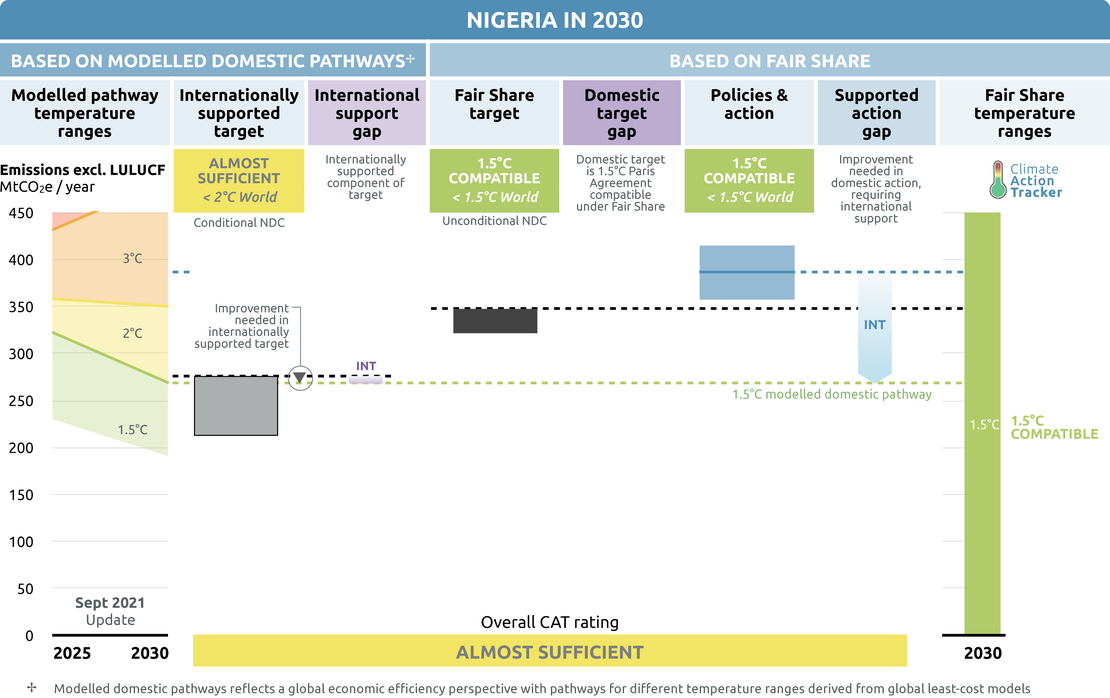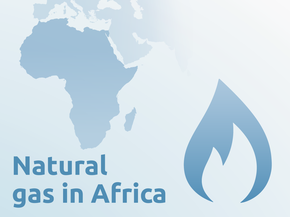Targets
Paris Agreement targets
NDC description
Nigeria submitted its updated NDC in July 2021 (Federal Government of Nigeria, 2021). The update included a substantially revised business-as-usual (BAU) projection for 2030, half of what was projected in Nigeria’s first NDC submission.
Nigeria is committed to reducing its emissions by 20% below BAU by 2030 (incl. LULUCF) unconditionally and will reduce its emissions by up to 47% below BAU by 2030, conditional on international support.
The CAT estimates that the unconditional target equates to an emissions level of 321-348 MtCO2e (excl. LULUCF) in 2030 (12-21% above 2010 levels) and the conditional target equates to 213-276 MtCO2e (excl. LULUCF) in 2030 (4-26% below 2010 levels). There is a high degree of uncertainty in these estimates due to a lack of information on projected land sector emissions in 2030 and the extent to which this sector contributes to the NDC target. Due to this uncertainty, we estimate the targets excluding LULUCF using a range of assumptions on the contribution from the land sector (see assumptions for more details).
The CAT rates Nigeria’s conditional target (“internationally supported target”) as “Almost sufficient” when compared to modelled domestic pathways and its unconditional target (“fair share target”) as “1.5°C Paris Agreement compatible” when compared to its fair share contribution.
In its NDC update, Nigeria has committed to reducing emissions by 47% below BAU by 2030, conditional on international support. This is equivalent to an emissions level 4-26% below 2010 levels excluding LULUCF by 2030. While this is a strong conditional target, Nigeria will need to strengthen its policies to make sure it has the enabling conditions in place to meet the target, in addition to receiving international support.
The CAT rates Nigeria’s 2030 conditional target as “Almost sufficient,” a rating that indicates that Nigeria’s internationally supported target in 2030 is not yet consistent with the Paris Agreement’s 1.5°C temperature limit but could be, with moderate improvements. If all countries were to follow Nigeria’s approach, warming could be held below—but not well below—2°C.
Nigeria’s conditional target spans the CAT’s ‘Almost sufficient’ and 1.5°C compatible ratings. The large target range is due to uncertainty around the extent to which Nigeria plans to rely on the land sector in meeting its target. Further clarity from Nigeria on this may result in a 1.5°C compatible target.
In its NDC update, Nigeria has recommitted to unconditionally reducing emissions 20% below BAU by 2030. This is equivalent to an emissions level of 12-21% above 2010 levels (excl. LULUCF) by 2030. The CAT rates Nigeria’s 2030 unconditional target as 1.5°C Paris Agreement compatible.
The “1.5°C Paris Agreement compatible” rating indicates that Nigeria’s fair share target is consistent with limiting warming to 1.5°C. Nigeria’s fair share target does not require other countries to make comparably deeper reductions or greater effort, and is in the most stringent part of its Fair Share range.
The fair share literature for Nigeria is sparse and some equity categories have few data points. As a result, the upper bound of Nigeria’s fair share range is dominated by a handful of studies. This high range is not reflective of the majority of the literature, which indicates more stringent emission reductions. Future equity studies may help to improve the fair share analysis for Nigeria.
Last NDC update
In July 2021, Nigeria submitted an updated Nationally Determined Contribution (NDC) (Federal Government of Nigeria, 2021) that reiterates its unconditional target of 20% below BAU by 2030 submitted in the 2017 NDC, and increases the conditional target from 45% to 47% below BAU by 2030. The update provided revised historical data with a significantly lower BAU; about half the level of the original. The CAT uses these reductions and the revised BAU in its assessment of Nigeria’s NDC.
Nigeria has also expanded the gas coverage of its NDC to include HFCs and proposes to undertake abatement measures in the waste sector, which were not considered in the first NDC.
Net zero and other long-term target(s)
We evaluate the net zero target as: Target information incomplete
Nigeria is in the process of developing a long-term vision to 2050. There is also a climate change bill passed by Nigeria’s National Assembly that includes a net zero target for 2050-2070. The bill has been sent to the President for assent. Its final NDC update mentioned Nigeria’s aim to cut current emissions by 50% by 2050 and achieve net zero emissions ‘as early as possible in the second half of the century’. For the full analysis click here.
Further analysis
Country-related publications
Stay informed
Subscribe to our newsletter


